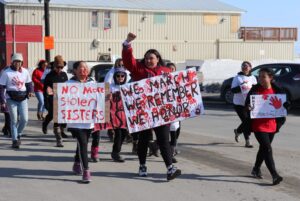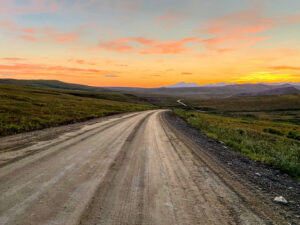Experts from around the state gathered in Nome last week to discuss marine mammals and how multiple entities can respond to different types of emergencies that may happen in the Bering Sea.
During a “Strait Science” talk hosted at UAF Northwest Campus, one of the presenters, Mandy Migura with the National Marine Fisheries Service (NMFS), discussed how marine mammal stranding events take place in Alaska sporadically but have been rising in numbers since tracking began in the 1980s.
“Strandings involve live marine mammals; these may be animals that are unable to return to their natural habitat without some kind of assistance. And they may be injured, they may be entangled in gear or marine debris, they may be entrapped — ice entrapment, ice may form up and they’re in an area where they can’t get back to where they should be — or they may be disoriented, may be a health issue or something in the environment that’s affecting them.”
Migura is Alaska’s Marine Mammal Stranding Coordinator and says dead marine mammals can also be categorized as stranded.
With more cases of marine mammal strandings being reported, the Bering Sea marine ecosystem is currently in a volatile state. Gay Sheffield, the Nome-based marine advisory agent, mentioned how sharks have been found more frequently in the Bering Straits region, with the latest one documented in Gambell last summer (2017). On the other side of St. Lawrence Island, a stellar sea lion was harvested in Savoonga last year which she says is uncommon.
Migura says local and regional partners reporting this kind of information greatly benefits NMFS.
“We don’t have enough staff across all of the coastal states to be everywhere to be able to track all of these marine mammals, so we like to have partners in this. And sometimes it’s the partners who are actually able to collect data on uncommon species that we would not be able to have otherwise.”
According to Migura, NMFS uses the gathered info from its partners for case studies on healthy or non-healthy subsistence harvested animals, and for the office to do bio-surveillance.
Not only are the types of animals found in the Bering Sea changing, but so is the vessel traffic; as the other presenter Sadie Wright, the lead for Oil Spill Response for Marine Mammals under NMFS, mentioned Thursday night. She says in 2012, her office saw few written protocols for oil spill response in the Arctic, so they started to write regionally-specific ones.
“And then in 2012 you guys started seeing some oiled seals in this region, and there was more oiled wildlife observed here in 2013 and 2014. And the communication, sampling, and response to that left a lot to be desired. We wanted to figure out how to make communications better so that we could trade information more quickly with the people that live here, so we could figure out what was going on and what could be done to help.”
Happening concurrently with the Strait Science presentation was an oil spill workshop on Friday at UAF’s Northwest campus. Multiple employees from Kawerak, including Austin and Brandon Ahmasuk, along with Sheffield, Wright and Migura, sat down with other experts like Michael Ziccardi, director of the oiled wildlife care network in UC Davis, California.
As this group of ten individuals discussed response plans to an oil spill in the Bering Sea, it became apparent that this would be a complex scenario, potentially involving a multitude of federal U.S. agencies and maybe even Russian entities. Sheffield pointed to incidents on the Russian side of the Strait where at least three fuel-carrying vessels have sunk to the bottom of the sea over the last decade.
Wright emphasized that NMFS and the other entities planning for a potential disaster now will help restoration and recovery efforts later.
“So when a disaster happens, we can be ready to respond quickly. Not only to help animals who might be injured or hurt, but to learn more about why they’re injured or hurt or dead, so that we can try to figure out if there’s something that we can do, big picture, to prevent that from happening. Or to help improve their situations so that they can recover more quickly after a disaster.”
If a big oil spill were to happen in the Bering Straits region right now, then Wright says most likely the Coast Guard would lead the response with various state agencies. However, it is unclear as to how quickly they would respond, as the nearest agency is based 500 miles or more away from Nome.
Image at top: Bering Sea coastline near Nome, October 2017. Photo: Zoe Grueskin/KNOM.




